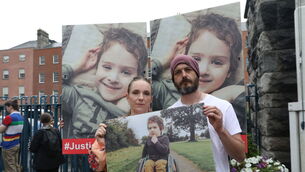Irish Examiner view: One is the loneliest number that you’ll ever do

Unbundling people’s feelings and perceptions and turning them into something actionable is no easy matter.
It is one of the great paradoxes of modern life that, in a world where people are connected like never before, those claiming that they are “lonely” seem to rise relentlessly.
The topic was sharply ventilated this week before the Oireachtas education committee after two-year-old research identifying Ireland as “the loneliest country in the EU” was cited in a debate about a decline in what is described as “third spaces” where young people can socialise and congregate for free in a safe environment.
The case that youth work services have suffered from a lack of sufficient Government investment was made by Sinéad Keane, the chief executive of SpunOut, the digitally-led mental health and wellbeing charity for young people.
And some aspects of it were challenged by the Independent senator Joe Conway.
He asked for the statistical base for the claim (data was collected online from 25,646 respondents across 27 EU members in 2022) before querying whether there was a “dimension of snowflake syndrome” in some of the responses.
It was, said Mr Conway, an “immensely depressing handle to throw on the youth of Ireland”.
The term “snowflake”, meaning an overly sensitive or easily offended and fragile person, has entered the cultural and political lexicon over the past 15 years gaining currency on social media.
And it’s easy to understand that, in a nation of such apparent bounty and achievement, there will be those, usually drawn from older generations, who wonder what the problem is?
Ms Keane fought her corner, pointing to the 24-hour crisis text line which her organisation provides.
More than 45,000 young people have used it so far this year with one in five identifying loneliness as their top issue.
That’s 9,000 youngsters, a significant number.
Unbundling people’s feelings and perceptions and turning them into something actionable is no easy matter.
But a good starting point is to recognise that there is a tangible issue here.
There is no shortage of supporting evidence, although much of it can be contradictory.
The Government’s , published in 2023, found that in those golden years pre-covid, the sense of optimism among our youth was among the highest in Europe.
There has been a subsequent decline, but is there any age group which is inviolate from the sense that the 2020s has been a period where well-being, fun and joy, has been in short supply?
We’re not quite there yet, but it is possible to wonder whether 2030 will echo the words of WH Auden in his poem which marked the day that Hitler invaded Poland.
“As the clever hopes expire of a low dishonest decade” observed the poet “waves of anger and fear circulate.”
You cannot really blame anyone for feeling the occasional bout of depression about the way the world is going.
But the question is whether it is tenable to allow this to become a defining characteristic of life.
Challenging this requires social interactions which go beyond the superficiality and transience of social media.
The family psychotherapist Richard Hogan put this well in his column for the this summer when he described his response to parents who fret about how to get their children off their phones.
If they weren’t on their phone, he asks, what would they be doing? That question, he said, was often met by a long silence.
We must do more to get young people out of their rooms and connected to various activities and social groups otherwise we contribute to the narrowing of the world and, with it, the pervasive sense of isolation.
Which returns us to the point being made to Leinster House by Sinéad Keane this week.
As the words of the song remind us, "one can be the loneliest number that you’ll ever do."
Given the Portuguese theme that is running through Ireland this week, it is worth recalling the insight of one José Mourinho when he was asked what scared him in life.
Talking ahead of a match when he was manager of Chelsea, he told surprised journalists: “For me, pressure is bird flu. I’m feeling a lot of pressure with the problem in Scotland. It’s not fun, and I’m more scared of it than football.
“What is football compared with life? A swan with bird flu, for me, that is the drama of the last two days. I have to buy some masks and stuff. I am serious.”
That was back in 2006 when there was an outbreak of bird flu in Fife on the east coast of Scotland.
In the past 20 years, there have been several hundred confirmed cases of bird flu in Britain in both wild birds and poultry, and a few dozen in the Republic of Ireland.
What, then, should we make of the news that there have been confirmed findings of the virus crossing to non-avian wildlife in Britain, with seals the biggest victims?
As we reported this week, while there are no known cases of bird flu passing over to mammals in Ireland, the strain has been discovered in sea birds on Irish coasts not far from our seal colonies.

Experts from Seal Rescue Ireland and Whale Watch are anxiously monitoring developments, while more outbreaks have been reported around the Republic.
Some 8,000 birds have had to be culled at a large turkey farm near Kells, Co Meath, while another 3,000 were euthanised at a commercial operation in Co Carlow.
Meanwhile, Fota Wildlife Park in Cork is closed until the end of November after 12 instances of the virus were identified.
With operational expenses averaging €120,000 each week, monthly losses at Fota threaten to mount into the hundreds of thousands.
The National Parks and Wildlife Service is undertaking aerial surveys of the country’s grey seal population.
No deaths have been recorded to date. But in Britain, 15 grey seal carcasses in Norfolk tested positive earlier this year.
The impact upon seal populations can be measured most dramatically in the South Atlantic, where 53,000 female elephant seals — half the breeding population — are estimated to have died on South Georgia since 2023, raising fears of an extinction-level event.
Last year, tourists on Antarctic cruise ships said the route to the grave of Irish explorer Ernest Shackleton at Grytviken Cemetery had become impassable due to “dead seals blocking the way”.
That 2006 case highlighted by Mourinho was an early taste of things to come, as cabinet papers from the Scottish first minister have revealed.
It gave political leaders their first exposure to pandemic planning, with discussions on school closures, vaccinations, and warnings about “panic and civil disobedience”.
We have learned lessons from covid and the danger of zoonotic viruses. The utmost vigilance is required in the spread of bird flu.
There’s not much positive to be said about the impact of VAR on modern soccer.
But for one brief shining moment, we can celebrate the exception that proves the rule.
There is the greater good of the sport, and then there is that German word schadenfreude, meaning to take delight in the misfortunes of others.
Is there any Irish person who would sacrifice the delicious seconds as the world’s greatest player, Portugal’s Cristiano Ronaldo, saw his antics turned back on him when a yellow card for felling Dara O’Shea with his elbow was upgraded to an automatic red, which threatens his future participation in the World Cup?

Irish supporters at the Aviva hugged each other with joy; they play-acted the crying gestures which Ronaldo, 40, had aimed in their direction; they laughed as they waved him off the field; they checked the flight schedules for tomorrow’s crucial match in Hungary.
In a month which has seen a cinematic retelling of the agonies of Saipan, this was a night to remember, not least for the two-goal hero Troy Parrott returning to Dublin from his new home at AZ Alkmaar.
Now we need to keep dreaming with a win against Hungary. And two more after that.















